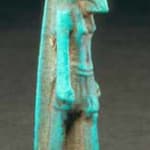26th Dynasty Faience Amulet of Thoth, 305 BCE - 100 CE
Faience
X.0323
This turquoise-blue faience amulet represents an ibis-headed male figure in the classic Egyptian attitude of striding forward with his left leg advanced on an integral base to which is attached...
This turquoise-blue faience amulet represents an ibis-headed male figure in the classic Egyptian attitude of striding forward with his left leg advanced on an integral base to which is attached an integral back pillar. The figure wears a belted, striated kilt and striated, tripartite wig. His arms are held down along the sides of his body and his hand holds an ankh-sign. The torso modeling is characterized by a pronounced bipartition with emphasis placed on the stomach and lower abdomen. The dating of this amulet of Thoth, god of wisdom, is suggested by the color of the faience used, a color which was extremely popular during the Ptolemaic and early Roman Imperial Period in Egypt.
Despite the plurality of meanings inherent in visual symbols in ancient Egyptian culture, the ibis appears to have been reserved almost exclusively for associations with Thoth, the god of wisdom, inventor of the hieroglyphs, and patron of scribes. Why this particular bird should have come to be associated with Thoth is shrouded in mystery and remains an enigma, but the association may ultimately derive from the fact that Thoth’s sacred site, Ashumunein in Middle Egypt, employs the hieroglyph of the ibis in the writing of the name of the nome, or province, in which this city is located. The small scale of this amulet suggests that it served a funerary function, a function which is reinforced by its turquoise blue color. Objects so colored are imbued with concepts of rebirth, regeneration, and fecundity. Those concepts are emphasized by the ankh-sign, symbol of life, which Thoth holds in his hand. Because Thoth was believed to record the verdict in the Hall of Judgment when the heart of the deceased was weighed against the feather of Maat, the blue color of the faience in association with the ankh-sign indicate that this amulet symbolized the triumph of the deceased at that tribunal and eternal existence in the Hereafter.
Carol Andrews, Amulets of Ancient Egypt (Austin 1994), frontis and page 24, figure 20, for two similar examples in London, The British Museum, neither of which, however, holds an ankh-sign in its hands. Dorothea Arnold, An Egyptian Bestiary (New York 1995), page 63, for the use of this particular color of faience as a dating criterion. Wolfgang Helck and Eberhard Otto, Kleines Lexikon der Ägyptologie [edited by Rosemarie Drekhahn] (Wiesbaden 1999), 310-311, for a succinct discussion of the god Thoth and the animals associated with his cult.
Despite the plurality of meanings inherent in visual symbols in ancient Egyptian culture, the ibis appears to have been reserved almost exclusively for associations with Thoth, the god of wisdom, inventor of the hieroglyphs, and patron of scribes. Why this particular bird should have come to be associated with Thoth is shrouded in mystery and remains an enigma, but the association may ultimately derive from the fact that Thoth’s sacred site, Ashumunein in Middle Egypt, employs the hieroglyph of the ibis in the writing of the name of the nome, or province, in which this city is located. The small scale of this amulet suggests that it served a funerary function, a function which is reinforced by its turquoise blue color. Objects so colored are imbued with concepts of rebirth, regeneration, and fecundity. Those concepts are emphasized by the ankh-sign, symbol of life, which Thoth holds in his hand. Because Thoth was believed to record the verdict in the Hall of Judgment when the heart of the deceased was weighed against the feather of Maat, the blue color of the faience in association with the ankh-sign indicate that this amulet symbolized the triumph of the deceased at that tribunal and eternal existence in the Hereafter.
Carol Andrews, Amulets of Ancient Egypt (Austin 1994), frontis and page 24, figure 20, for two similar examples in London, The British Museum, neither of which, however, holds an ankh-sign in its hands. Dorothea Arnold, An Egyptian Bestiary (New York 1995), page 63, for the use of this particular color of faience as a dating criterion. Wolfgang Helck and Eberhard Otto, Kleines Lexikon der Ägyptologie [edited by Rosemarie Drekhahn] (Wiesbaden 1999), 310-311, for a succinct discussion of the god Thoth and the animals associated with his cult.



